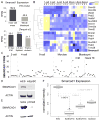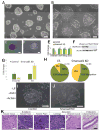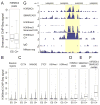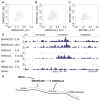SMARCAD1 Contributes to the Regulation of Naive Pluripotency by Interacting with Histone Citrullination
- PMID: 28355564
- PMCID: PMC5466819
- DOI: 10.1016/j.celrep.2017.02.070
SMARCAD1 Contributes to the Regulation of Naive Pluripotency by Interacting with Histone Citrullination
Abstract
Histone citrullination regulates diverse cellular processes. Here, we report that SMARCAD1 preferentially associates with H3 arginine 26 citrullination (H3R26Cit) peptides present on arrays composed of 384 histone peptides harboring distinct post-transcriptional modifications. Among ten histone modifications assayed by ChIP-seq, H3R26Cit exhibited the most extensive genomewide co-localization with SMARCAD1 binding. Increased Smarcad1 expression correlated with naive pluripotency in pre-implantation embryos. In the presence of LIF, Smarcad1 knockdown (KD) embryonic stem cells lost naive state phenotypes but remained pluripotent, as suggested by morphology, gene expression, histone modifications, alkaline phosphatase activity, energy metabolism, embryoid bodies, teratoma, and chimeras. The majority of H3R26Cit ChIP-seq peaks occupied by SMARCAD1 were associated with increased levels of H3K9me3 in Smarcad1 KD cells. Inhibition of H3Cit induced H3K9me3 at the overlapping regions of H3R26Cit peaks and SMARCAD1 peaks. These data suggest a model in which SMARCAD1 regulates naive pluripotency by interacting with H3R26Cit and suppressing heterochromatin formation.
Keywords: ChIP-seq; SMARCAD1; citrullination; histone modification; naive state; pluripotency; protein array; stem cells.
Copyright © 2017 The Author(s). Published by Elsevier Inc. All rights reserved.
Figures






Similar articles
-
Citrullination regulates pluripotency and histone H1 binding to chromatin.Nature. 2014 Mar 6;507(7490):104-8. doi: 10.1038/nature12942. Epub 2014 Jan 26. Nature. 2014. PMID: 24463520 Free PMC article.
-
SMARCAD1 and TOPBP1 contribute to heterochromatin maintenance at the transition from the 2C-like to the pluripotent state.Elife. 2025 Feb 19;12:RP87742. doi: 10.7554/eLife.87742. Elife. 2025. PMID: 39969508 Free PMC article.
-
Trim28 citrullination maintains mouse embryonic stem cell pluripotency via regulating Nanog and Klf4 transcription.Sci China Life Sci. 2023 Mar;66(3):545-562. doi: 10.1007/s11427-022-2167-3. Epub 2022 Sep 8. Sci China Life Sci. 2023. PMID: 36100837
-
Histone variants in pluripotency and disease.Development. 2013 Jun;140(12):2513-24. doi: 10.1242/dev.091439. Development. 2013. PMID: 23715545 Review.
-
A regulatory circuitry locking pluripotent stemness to embryonic stem cell: Interaction between threonine catabolism and histone methylation.Semin Cancer Biol. 2019 Aug;57:72-78. doi: 10.1016/j.semcancer.2019.01.005. Epub 2019 Jan 30. Semin Cancer Biol. 2019. PMID: 30710616 Review.
Cited by
-
Padi2/3 Deficiency Alters the Epigenomic Landscape and Causes Premature Differentiation of Mouse Trophoblast Stem Cells.Cells. 2022 Aug 9;11(16):2466. doi: 10.3390/cells11162466. Cells. 2022. PMID: 36010543 Free PMC article.
-
ZFP451-mediated SUMOylation of SATB2 drives embryonic stem cell differentiation.Genes Dev. 2021 Aug 1;35(15-16):1142-1160. doi: 10.1101/gad.345843.120. Epub 2021 Jul 8. Genes Dev. 2021. PMID: 34244292 Free PMC article.
-
Hippo-YAP signaling controls lineage differentiation of mouse embryonic stem cells through modulating the formation of super-enhancers.Nucleic Acids Res. 2020 Jul 27;48(13):7182-7196. doi: 10.1093/nar/gkaa482. Nucleic Acids Res. 2020. PMID: 32510157 Free PMC article.
-
PADI4-mediated citrullination of histone H3 stimulates HIV-1 transcription.Nat Commun. 2025 Jun 25;16(1):5393. doi: 10.1038/s41467-025-61029-0. Nat Commun. 2025. PMID: 40562767 Free PMC article.
-
Building Pluripotency Identity in the Early Embryo and Derived Stem Cells.Cells. 2021 Aug 10;10(8):2049. doi: 10.3390/cells10082049. Cells. 2021. PMID: 34440818 Free PMC article. Review.
References
-
- ACTIVEMOTIF. MODified(TM) Histone peptide Array Manual. 2014 Available: http://www.activemotif.com/documents/1691.pdf.
-
- ADRA CN, DONATO JL, BADOVINAC R, SYED F, KHERAJ R, CAI H, MORAN C, KOLKER MT, TURNER H, WEREMOWICZ S, SHIRAKAWA T, MORTON CC, SCHNIPPER LE, DREWS R. SMARCAD1, a novel human helicase family-defining member associated with genetic instability: cloning, expression, and mapping to 4q22-q23, a band rich in breakpoints and deletion mutants involved in several human diseases. Genomics. 2000;69:162–73. - PubMed
-
- BRONS IG, SMITHERS LE, TROTTER MW, RUGG-GUNN P, SUN B, CHUVA DE SOUSA LOPES SM, HOWLETT SK, CLARKSON A, AHRLUND-RICHTER L, PEDERSEN RA, VALLIER L. Derivation of pluripotent epiblast stem cells from mammalian embryos. Nature. 2007;448:191–5. - PubMed
MeSH terms
Substances
Grants and funding
LinkOut - more resources
Full Text Sources
Other Literature Sources
Molecular Biology Databases

